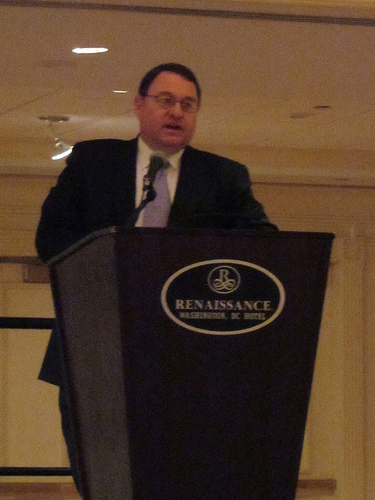NTIA Previews National Broadband Map
WASHINGTON February 17, 2011 – Assistant Secretary for Communications and Information, Lawrence Strickling, presented a brief preview of the national broadband map and an update on the activities of the National Telecommunications and Information Administration (NTIA) at the annual winter meeting of
WASHINGTON February 17, 2011 – Assistant Secretary for Communications and Information, Lawrence Strickling, presented a brief preview of the national broadband map and an update on the activities of the National Telecommunications and Information Administration (NTIA) at the annual winter meeting of the National Association of Regulatory Utility Commissioners on Wednesday.

NTIA Assistant Secretary for Communications, Lawrence Strickling, addresses attendees at NARUC's annual winter meeting.
NTIA will not unveil the broadband map until Thursday, but Strickling revealed that the map contains over 25 million pieces of data.
“This is the most granular map ever created,” he said, “it goes all the way down to the census block level. It will allow consumers to input their address and receive a list of the broadband providers in their area along with direct links to the provider’s websites.”
Strickling highlighted that NTIA will release the map not only on time, but under budget. The leftover funding for broadband mapping was given to states by NTIA for use in expanding existing broadband capacity.
While Strickling would not reveal any more details about the map, he did say that “after seeing the data we were reassured that the grants we administered went to areas that needed them.” One of the criticisms of the Broadband Technology Opportunities Program by Republicans was that grants were awarded prior to the completion the broadband availability map. These critics believed that the grants would go to areas which already might have access but the government did not have the proper data to determine the level of access.
“Many people thought the hard part was awarding the grants,” Strickling said, “but really the hard part is going to be the continuous work we do with the grantees to ensure they are able to build their projects on time and within the guidelines.”
Many BTOP projects have yet to be completed due to the long process of obtaining environmental assessments and work permits, but a number of the public computing grant projects are currently up and running. These projects were primarily located within existing libraries and community centers that only needed computers and funding to obtain access. One of the things that NTIA discovered from the analyzing the mapping data along with usage practices was that schools need 100Mbps per 1,000 students to provide adequate access.
While the data received from these projects is still preliminary and raw Strickling indicated that NTIA has found an uptick in broadband subscription in areas where the projects are running.
“Bringing computers to these centers is easy,” he said. “What these projects are also doing is providing the community with digital literacy skills and showing them the value of the Internet.”
Strickling then addressed the allegations that BTOP will create overbuild – the building of a network in an area where one already exists.
“The overbuild problem is overblown,” he asserted. “Our goal was to bring service to areas that, by definition, do not have enough service for the community. Additionally, in areas where overbuild may occur the networks we are deploying are open. This will allow the incumbents to use them to provide better service to their customers. ”









Member discussion